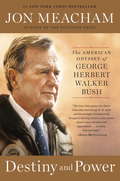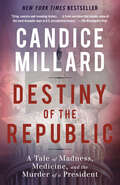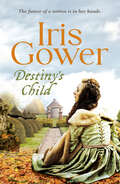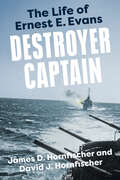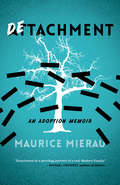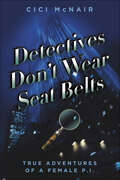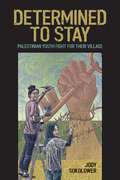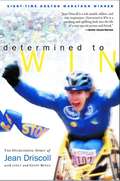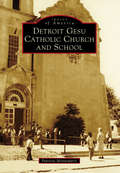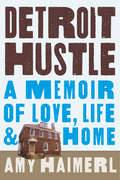- Table View
- List View
Destiny
by Alam LembangThis is a life story that spans almost 80 years and covers four continents. It all started when I was a child, reading adventurous books made me wish in my mind to meet one day Undine the Sea Goddess and to be a geologist. By the favor of God, my wish came true by getting a scholarship to Romania while I was in Indonesia. During my study in Bucharest, I met a very beautiful girl whose name was very close to Undine. We fell in love and got married. After graduating as a geophysicist, I took my family to work in many countries. We finally settled in the United States and got US citizenship in 1990. Unfortunately, my wife passed away in 1998. I took her remains to Bucharest and buried her there. Since then, I decided to spend the rest of my life in Bucharest, to be close to her. Life is a journey in time and space. As a journey starts from some point, it must also have an end. At this moment, I think, I am nearer to the end, which is my DESTINY.
Destiny and Power: The American Odyssey of George Herbert Walker Bush
by Jon MeachamIn this brilliant biography, Jon Meacham, the Pulitzer Prize–winning author, chronicles the life of George Herbert Walker Bush. Drawing on President Bush’s personal diaries, on the diaries of his wife, Barbara, and on extraordinary access to the forty-first president and his family, Meacham paints an intimate and surprising portrait of an intensely private man who led the nation through tumultuous times. From the Oval Office to Camp David, from his study in the private quarters of the White House to Air Force One, from the fall of the Berlin Wall to the first Gulf War to the end of Communism, Destiny and Power charts the thoughts, decisions, and emotions of a modern president who may have been the last of his kind. This is the human story of a man who was, like the nation he led, at once noble and flawed.<P><P> His was one of the great American lives. Born into a loving, privileged, and competitive family, Bush joined the navy on his eighteenth birthday and at age twenty was shot down on a combat mission over the Pacific. He married young, started a family, and resisted pressure to go to Wall Street, striking out for the adventurous world of Texas oil. Over the course of three decades, Bush would rise from the chairmanship of his county Republican Party to serve as congressman, ambassador to the United Nations, head of the Republican National Committee, envoy to China, director of Central Intelligence, vice president under Ronald Reagan, and, finally, president of the United States. In retirement he became the first president since John Adams to see his son win the ultimate prize in American politics.<P> With access not only to the Bush diaries but, through extensive interviews, to the former president himself, Meacham presents Bush’s candid assessments of many of the critical figures of the age, ranging from Richard Nixon to Nancy Reagan; Mao to Mikhail Gorbachev; Dick Cheney to Donald Rumsfeld; Henry Kissinger to Bill Clinton. Here is high politics as it really is but as we rarely see it.<P> From the Pacific to the presidency, Destiny and Power charts the vicissitudes of the life of this quietly compelling American original. Meacham sheds new light on the rise of the right wing in the Republican Party, a shift that signaled the beginning of the end of the center in American politics. Destiny and Power is an affecting portrait of a man who, driven by destiny and by duty, forever sought, ultimately, to put the country first.
Destiny of the Republic: A Tale of Madness, Medicine and the Murder of a President
by Candice MillardNATIONAL BESTSELLER • The extraordinary account of James Garfield's rise from poverty to the American presidency, and the dramatic history of his assassination and legacy, from the bestselling author of The River of Doubt."Crisp, concise and revealing history.... A fresh narrative that plumbs some of the most dramatic days in U.S. presidential history." —The Washington Post James Abram Garfield was one of the most extraordinary men ever elected president. Born into abject poverty, he rose to become a wunderkind scholar, a Civil War hero, a renowned congressman, and a reluctant presidential candidate who took on the nation's corrupt political establishment. But four months after Garfield's inauguration in 1881, he was shot in the back by a deranged office-seeker named Charles Guiteau. Garfield survived the attack, but become the object of bitter, behind-the-scenes struggles for power—over his administration, over the nation's future, and, hauntingly, over his medical care. Meticulously researched, epic in scope, and pulsating with an intimate human focus and high-velocity narrative drive, The Destiny of the Republic brings alive a forgotten chapter of U.S. history.Look for Candice Millard&’s latest book, River of the Gods.
Destiny's Child
by Iris GowerIt was said in a prophecy that she would bring forth a King of England in this novel based on the life and loves of Margaret Beaufort, mother of Henry VII. Margaret Beaufort was rich, beautiful, and just thirteen years of age when she discovered that she carried the future King of England within her body. Forced to give him up as a web of intrigue and danger was spun around her son, she entrusted the child to the care of his uncle, Jasper Tudor, who would have laid down his life for the Lancastrian cause. Caught up in the Wars of the Roses, Margaret was banished from court in disgrace, and although she later won the love and loyalty of three powerful men, becoming the wife of each in turn, her heart remained true to Edmund Tudor, the father of her son. And through a lifetime of joy, sorrow and shame Margaret Beaufort never wavered from her devotion to her son, vowing that whatever the cost, one day he should be Henry VII, King of England. A deeply moving historical love story, perfect for fans of Philippa Gregory, Elizabeth Chadwick, and Kate Mosse.
Destroyed
by Jayne SterneWhen eight-year-old Jayne left bomb-torn Northern Ireland, her family stayed with relations and a distant relative began a campaign of abuse so horrifying that her world was shattered forever. When the family moved again, Jayne thought the nightmare was over. She was wrong. Her relative came too. And, as her parents had to work nights, Jayne's abuser became her carer. Raped repeatedly by him, beaten, abused and battered, Jayne's life was a living hell. One thing kept Jayne sane: the love and care of her older brother, Stuart. But he had demons of his own, and Jayne watched in helpless despair as the boy who had always protected her turned into an adult consumed by rage. Out of control and on the edge, Stuart went on to commit one of the most terrible crimes of recent years.DESTROYED is the heart-stopping tale of an innocence stolen and a family torn apart told by a woman who has finally managed to confront her harrowing past.
Destroyed
by Jayne SterneWhen eight-year-old Jayne left bomb-torn Northern Ireland, her family stayed with relations and a distant relative began a campaign of abuse so horrifying that her world was shattered forever. When the family moved again, Jayne thought the nightmare was over. She was wrong. Her relative came too. And, as her parents had to work nights, Jayne's abuser became her carer. Raped repeatedly by him, beaten, abused and battered, Jayne's life was a living hell. One thing kept Jayne sane: the love and care of her older brother, Stuart. But he had demons of his own, and Jayne watched in helpless despair as the boy who had always protected her turned into an adult consumed by rage. Out of control and on the edge, Stuart went on to commit one of the most terrible crimes of recent years.DESTROYED is the heart-stopping tale of an innocence stolen and a family torn apart told by a woman who has finally managed to confront her harrowing past.
Destroyer Captain: The Life of Ernest E. Evans (American War Heroes)
by James D. Hornfischer David J. HornfischerFrom James D. Hornfischer, New York Times bestselling author of The Last Stand of the Tin Can Soldiers, a riveting account of the life of WWII hero Commander Ernest E. Evans and his heroics and sacrifice during the Leyte Gulf Battle of Samar. For the first time ever, acclaimed naval historian James D. Hornfischer, &“the dean of World War II naval history," writing with his son David J. Hornfischer, explores Capt. E. Evans&’s incredible story, from his humble upbringing as a child of a Cherokee and Creek family in Pawnee, Oklahoma, and his graduation from the Naval Academy in 1931, to his service on fighting ships during the Pacific War and his selfless bravery and cool command during a valiant faceoff with the pride of the Japanese Navy. Interspersed with impeccable research, interviews with men who fought alongside Capt. E. Evans, and thrilling anecdotes about United States Navy experiences during WWII, Destroyer Captain provides insight into an incredible man who spent his life beating the odds through courage, ability, and sheer determination. Never were these attributes better on display than on the morning of October 25, 1944, when, in the waters off Samar, a small flotilla of US Navy ships encountered a Japanese fleet superior in both vessels and firepower. Aboard the USS Johnston, Capt. Ernest E. Evans seized the moment, ordering his destroyer to steam forward and attack. Heavily outgunned, Evans and his sailors fired torpedo after torpedo, all the while maneuvering to dodge enemy shells, as two other American destroyers joined the fight. It was a valiant last stand for Capt. E. Evans, one of the toughest warriors in the Navy, but thanks to his bravery and steadiness under fire, these dogged Americans routed one of the most powerful naval forces that Tokyo had ever put to sea. A remarkable story of patriotism and courageousness, Destroyer Captain honors a singular American hero whose name shall never be forgotten.
Desvío sobre un elefante: Un año bailando en el mayor espectáculo del mundo
by Alejandra Gutierrez Barbara File MarangonLas memorias de una bailarina de ballet que abandona sus zapatillas de punta para montar un elefante en el circo Ringling Bros. y Barnum & Bailey en 1978.
Det var min hjemstavn
by Cristiano ParafioritiGjennom tjue fortellinger gir forfatteren liv til personligheter, berusende lukter og tradisjonsrike smaksopplevelser i en tegning av sin oppvekst på Sicilia. Det sydliges dempede stemme siver ut av disse sidene, kvalt av reignasjon og tristhet. Men også med en kjærlighet til en fortid og en jord, fattig og blodfarget, utmattet og såret av armot, urett og fraflytting, men for alltid levende i minnet til dem som har forlatt den. Og dette minnet fester seg i sjelen og fyller hjertet. Det former en emosjonell rest som det flyter over med i form av ord, tanker og bilder fra en tid, en dag eller et øyeblikk som har vært levd og som fortsatt gir emosjoner.
Detachment: An Adoption Memoir
by Maurice MierauIn 2005, Maurice Mierau and his wife, Betsy, travelled to Ukraine to adopt two small boys, age three and five. After weeks of delays while navigating a tangled bureaucracy, they returned to Canada as a proud new family of four. Now what? Does fatherhood begin the moment that the adoption papers are signed? Is family something that is created in an instant? And what happens when everything seems to be on the verge of falling apart? In Detachment, Maurice Mierau probes not only the process of adoption but what comes after—the challenges of becoming a family, the strain on his marriage. While his son acts out and gets in trouble at school, Maurice feels removed, detached, thinking instead about his own emotionally distant father. Also born in Ukraine, Maurice’s father has a traumatic and mysterious past of his own. If Maurice can come to understand his father’s life, perhaps he can start to make sense of his new sons… Detachment is a moving, darkly funny, and searingly unsentimental memoir about learning to become a father and a son.
Details from a Larger Canvas
by Helen McleanThe biggest surprise - and disappointment - that life holds is that it is over so fast. The golden tomorrow, to which most people (usually women) put off their hopes rarely appears. This is the lesson learned by Helen McLean in her memoir. Details from a Larger Canvas is about a woman with the expectations of her time and class heavy upon her shoulders; in short, she is supposed to be much the same woman as her Rosedale matron mother-in-law whose life was bound up in sets of rules and whose life had little expression except in the form of materialistic acquisition and censure. Instead, Helen creates her own life - and, while painting a portrait of Margaret Laurence, finds a woman with whom she has common ground.
Detained: A boy's journal of survival and resilience
by D. Esperanza Gerardo Iván MoralesThe first-ever memoir of a child&’s experience in detention on the US/Mexico border under President Trump&’s infamous family separation policy.D Esperanza was just thirteen years old when he lost his caregivers, his beloved grandmother and uncle. Since both of his parents were working and living in the United States, D was left on his own in a small town in Honduras. He quickly realized he simply could not make enough money to survive so he made the difficult decision to head north with his cousins and hopefully reunite with his parents in el norte. Together, the boys struggled to survive a long and treacherous journey through Central America and Mexico. Along the way, D and his cousins formed a deep bond, only for the four to be brutally separated at the border of the United States. When he is captured and processed at a facility, neither D nor his family are given an update on when he will be released or where he&’ll go next. Over the next five months, he kept a journal of his experience. The pages tell a story of pain, cruelty, friendship, and resilience, a living testament to the reality of the border. Amidst the senseless inhumanity and violence of US immigration policy, D found hope in the friendship he and his fellow companions forged, and mentorship from one intrepid advocate who fought on his behalf named Gerardo Iván Morales. Timely, powerful, and unforgettable, Detained brings the border crisis to vivid life.
Detectives Don't Wear Seat Belts: True Adventures of a Female P.I.
by Cici McNairGrowing up in Mississippi, Cici McNair was always more the tomboy her mother supported than the Southern belle her father demanded. She escaped her suffocating upbringing the first chance she had to travel the world. Whether working at the Vatican in Rome or consorting with a gunrunner in Haiti, she lived a life of international adventure. When Cici finds herself in New York, divorced, broke, and fashionably starving to death in a Madison Avenue apartment, she impulsively decides to become a private detective.But, as Cici soon learns, the world of P.I.s is tight-knit and made up almost exclusively of former law enforcement officers. By nature, they are a highly suspicious group and are especially wary of a newcomer with an untraceable past. Diligently working her way through the Yellow Pages, doggedly pursuing the slightest lead, Cici is finally hired by a private investigator willing to take a chance. The next day she's working side by side with a pair of seasoned detectives and a skip tracer who is scary to meet but like silk on the phone. She quickly realizes she'll need all her energy and wits to succeed in this new world.Being a private investigator is as exciting and liberating as Cici ever dreamed, from creating a false identity on the spot on her first case in the field to surviving adrenaline-rushing car chases. Working with law enforcement, she goes undercover, dealing with the ruthless Born to Kill gang in Chinatown and the Middle Eastern counterfeiters west of Broadway. A detailed account of the hidden world and real-life cases of a P.I., this action-packed memoir is as entertaining as any detective novel you've ever read.
Determined to Matter
by Dan O'Hara Jen O'HaraShannon O'Hara, skating down the ice chasing after the puck, comes face to face with a larger-than-life opposing team player. Never one to back down from anything, barely five feet fall, Shannon tangles with the player and ends up with a penalty. As she sits in the penalty box-only thinking about getting out in two minutes-no one would ever imagine that this beautiful, vibrant, and competitive young spirit will be gone in 54 days. The devastating news that 12-year-old Shannon is diagnosed with an inoperable brain tumor is unfathomable, surreal, and unimaginable. This is the raw and emotional story of the O'Hara's as they prepare for the fight of their lives, and their ultimate loss.Written and inspired by a blog that Dan and Jen O'Hara wrote to keep in touch with their family, friends, and supporters near and far, the story follows the yearlong battle from diagnosis to death and exemplifies how to live the "new normal" every day, no matter what it entails. Shannon's struggle reveals why family, faith, and hope are so important in our daily lives and how the support of a community plays such a vital role through the good times and especially the bad.
Determined to Stay: Palestinian Youth Fight for Their Village
by Jody SokolowerPalestinian youth and the fight for their village Silwan is a Palestinian village located just outside the ancient walls of the Old City of Jerusalem. Determined to Stay: Palestinian Youth Fight for Their Village is a moving story of a village and its people. As Silwani youth and community members share their lives with us, their village becomes an easily accessible way to understand Palestinian history and current reality. Written with young people in mind, the richly illustrated text stresses connections between the lives of youth in the US and Palestine: criminalization of youth, forced relocation, the impact of colonialism on Indigenous communities, efforts to bury history, and inspiring examples of resistance and resilience.
Determined to Win: The Overcoming Spirit of Jean Driscoll
by Janet Geoff Benge Jean DriscollSince 1990, Jean Driscoll has been one of the most inspiring leaders in women's sports. Her tenacity for winning at women's wheelchair racing has delivered her into the record books, and her charisma and enthusiasm for life has captured the hearts of audiences worldwide. Best known for her eight victories at the Boston Marathon and her two Olympic silver medals (1992, 1996), Jean has inspired both men and women, athletes and non-athletes, and those with and without physical disabilities. She's been featured on "Good Morning America, ABC Nightline, " and the "Today Show, " and twice in "USA Today. " A documentary highlighting Jean's life story, "Against the Wind, " has aired on over 400 PBS stations nationwide. In addition to training and racing, Jean serves as a corporate spokesperson for Ocean Spray Cranberries, Inc. As a motivational speaker, she delights in sharing her "Dream Big, Work Hard" message at conventions, corporations, schools, and with the media. Now in trade paperback, Determined to Win, chronicles Jean's journey from physical paralysis to true spiritual freedom.
Determined: The Autobiography
by Norman WhitesideNorman Whiteside is more than a cult hero to Manchester United fans. In his eight years with the club he came to embody their aspirations to such an extent that he was embraced as their on-field representative, the supporter on the pitch. In this fascinating autobiography, Whiteside reveals the workings of Old Trafford during the 1980s - the good, the bad, the booze and the arrival of Fergie. His stories of growing up in the sectarian violence of Belfast will shock many, whereas the determination he showed when rebuilding his life when his footballing career was destroyed by injury will act as an inspiration. His career is littered with unforgetable moments, among them the astonishing performance of the seventeen-year-old usurper of Pele's 'youngest ever' World Cup record as Northern Ireland beat Spain in Valencia in 1982.
Determined: The Autobiography
by Norman WhitesideNorman Whiteside is more than a cult hero to Manchester United fans. In his eight years with the club he came to embody their aspirations to such an extent that he was embraced as their on-field representative, the supporter on the pitch. In this fascinating autobiography, Whiteside reveals the workings of Old Trafford during the 1980s - the good, the bad, the booze and the arrival of Fergie. His stories of growing up in the sectarian violence of Belfast will shock many, whereas the determination he showed when rebuilding his life when his footballing career was destroyed by injury will act as an inspiration. His career is littered with unforgetable moments, among them the astonishing performance of the seventeen-year-old usurper of Pele's 'youngest ever' World Cup record as Northern Ireland beat Spain in Valencia in 1982.
Detour
by Lizzie SimonA finely wrought memoir of mental health, Detour takes a genre explored by Susanna Kaysen and Kay Redfield Jamison and propels it in a revelatory and rebellious new direction. Detour is the extraordinary first book by Lizzie Simon, a twenty-three-year-old woman with bipolar disorder. We meet her as she is set to abandon her successful career as a theatrical producer in New York City, with plans to hit the road and find other bipolars like herself -- young, ambitious, opinionated, and truth-seeking. Her goal: to speak with them candidly without judgment, fear, or the slightest trace of anything clinical or jargon-laden. She wants their stories in their words. But after falling in love with her first interviewee, a troubled millionaire, the truth and the path become increasingly difficult to find. She indeed finds inspiring bipolars. Marissa, a twenty-something African-American adoptee; Jan, a popular rock 'n' roll radio deejay and mother of two; Matt, a quiet college student from the South. Each is resilient, wise, healthy, and hopeful. Yet each harbors stories of mania and depression that defy the limits of human experience and survival. But if she's achieving what she set out to do, then why does she feel more alien and alone than ever? Part road trip, part love story, part mystery, Simon has created a heartbreaking narrative of her cross-country quest. With brave humor, Simon writes guilelessly about herself, her past, and her search for "a herd of her own." She explores that shifting gray area where illness and identity intersect and blur, with the eye of an insider and the heart and soul of a survivor. Accessible and unique, Detour not only opens an intimate window on the day-to-day condition of living with a mood disorder, it also speaks to our universally human struggle to become whole.
Detour: My Bipolar Road Trip in 4-D
by Lizzie SimonAfter being diagnosed with bipolar disorder, the author takes a road trip to meet others like herself
Detroit Gesu Catholic Church and School (Images of America)
by Patricia MontemurriIn a reconfigured farmhouse just a mile outside of the city limits of Detroit, a Jesuit priest and 25 men, women, and children gathered to celebrate Sunday mass on March 19, 1922. The Reverend John McNichols named the Catholic mission church Gesu, the Italian word for �Jesus.� Gesu became one of Detroit�s landmark parishes. Its history illustrates the Motor City�s boom, bust, resilience, and resurgence. It was the home parish of four Detroit mayors, powerful members of Congress, auto industry titans, sports legends, artists, authors, and actors. At its peak in the mid-1960s, Gesu School enrolled 1,600 students. Because of Detroit�s decline and its racial and economic struggles, Gesu is one of only four Catholic elementary schools that remain in the city. But as Detroit rebounds, Gesu School is growing again.
Detroit Hustle: A Memoir of Life, Love, and Home
by Amy HaimerlJournalist Amy Haimerl and her husband had been priced out of their Brooklyn neighborhood. Seeing this as a great opportunity to start over again, they decide to cash in their savings and buy an abandoned house for 35,000 in Detroit, the largest city in the United States to declare bankruptcy.As she and her husband restore the 1914 Georgian Revival, a stately brick house with no plumbing, no heat, and no electricity, Amy finds a community of Detroiters who, like herself, aren't afraid of a little hard work or things that are a little rough around the edges. Filled with amusing and touching anecdotes about navigating a real-estate market that is rife with scams, finding a contractor who is a lover of C.S. Lewis and willing to quote him liberally, and neighbors who either get teary-eyed at the sight of newcomers or urge Amy and her husband to get out while they can, Amy writes evocatively about the charms and challenges of finding her footing in a city whose future is in question. Detroit Hustle is a memoir that is both a meditation on what it takes to make a house a home, and a love letter to a much-derided city.
Detroit Red Wings: Greatest Moments and Players
by Stan FischlerOne of the National Hockey League’s “Original Six,” few teams in professional hockey have enjoyed more success than the Detroit Red Wings. In this newly revised edition, Stan “the Hockey Maven” Fischler profiles more than fifty of the greatest characters from this unforgettable franchise. Fans can read about everyone from the legendary Gordie Howe (who was almost killed by a body-check that fractured his skull before he went on to become known as “Mr. Hockey”) to Nicklas Lindström (who became the first European to win the Conn Smythe Trophy in 2002). With a deft pen, Fischler describes the Red Wings' greatest accomplishments from his front-row seat in the press box. Beyond the stats and facts, this veteran sportswriter brings fans off the ice and into the locker room to share a treasure trove of stories and anecdotes from this legendary franchise. Within these pages, fans will taste the adrenaline as the Red Wings rack up eleven Stanley Cup Championships and cheer with the crowd as Pete and Jerry Cusimano toss the first “good luck” octopus onto the ice. Without a doubt, Detroit Red Wings: Greatest Moments and Players is a must-have for any Red Wings fan.
Detroit Rock City: The Uncensored History of Rock 'n' Roll in America's Loudest City
by Steve MillerDetroit Rock City is an oral history of Detroit and its music told by the people who were on the stage, in the clubs, the practice rooms, studios, and in the audience, blasting the music out and soaking it up, in every scene from 1967 to today.From fabled axe men like Ted Nugent, Dick Wagner, and James Williamson jump to Jack White, to pop flashes Suzi Quatro and Andrew W.K., to proto punkers Brother Wayne Kramer and Iggy Pop, Detroit slices the rest of the land with way more than its share of the Rock Pie.Detroit Rock City is the story that has never before been sprung, a frenzied and schooled account of both past and present, calling in the halcyon days of the Grande Ballroom and the Eastown Theater, where national acts who came thru were made to stand and deliver in the face of the always hard hitting local support acts. It moves on to the Michigan Palace, Bookies Club 870, City Club, Gold Dollar, and Magic Stick - all magical venues in America's top rock city.Detroit Rock City brings these worlds to life all from the guys and dolls who picked up a Strat and jammed it into our collective craniums. From those behind the scenes cats who promoted, cajoled, lost their shirts, and popped the platters to the punters who drove from everywhere, this is the book that gives life to Detroit's legend of loud.

